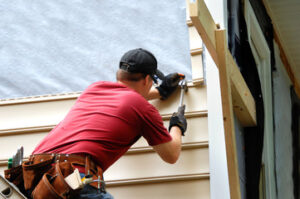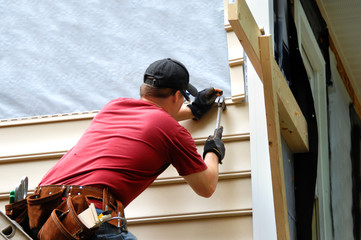Damaged siding is a breeding ground for mold and mildew, both of which pose health risks. Regular maintenance, including inspections and cleaning, helps control these potential problems, ensuring a safer, healthier living environment for you and your family.
Several factors impact the cost of Siding Repair Charleston SC including the size and scope of the problem. Thin isolated cracks and holes can be repaired with caulk, while larger issues require the removal of a damaged plank.
Cracks in vinyl siding can be unsightly and, if left unattended, can lead to water damage. They may also signal that the vinyl is failing. If you notice a crack, it’s important to schedule a repair before it widens or spreads. A quick fix can prevent your home’s exterior from being compromised and save you money on costly repairs down the road.
To repair cracked siding, you should first remove the damaged segment of your home’s exterior. A zip tool is an excellent tool to use for this task, as it works like a hook to separate the broken piece from the rest of the vinyl panel. Once the vinyl is removed, you should then cut a straight line along the top of the damaged section with a utility knife. It’s best to leave about 2 inches (5.1 cm) of space around the damaged area. This will help to prevent the vinyl from warping or stretching after it is repaired.
If the crack is less than a 1/16 inch, you can simply fill in the split with epoxy putty. To do this, first clean the area with warm soapy water to ensure the surface is free of dirt or ultraviolet rays that can cause the siding to deteriorate. Next, fold a piece of 100-grit sandpaper in half and run it over the crack, moving from one end of the split to the other. After sanding, wipe down the area to de-gloss it and make sure it’s completely dry before applying a primer.
Holes in vinyl siding are an unfortunate occurrence that can be difficult to repair without the assistance of professional contractors. However, if you can catch these holes before they grow, you should be able to avoid more severe problems, such as fungal growth and water intrusion.
For small divots and holes less than an inch in size, you can generally repair these using caulking that is matched to your siding. For larger holes, you will need a hole saw that’s slightly bigger than the damage. If the hole extends past the siding’s tar paper or house wrap, you can inject spray foam sealant to create a void that can be filled with epoxy.
Dents
Dents in your siding may not seem like a big deal, but they can weaken the material and cause serious problems later. In addition, they make it difficult to clean your home’s exterior and can trap water or debris. Regularly inspect your siding for dents and stains, and address them quickly before they grow into bigger issues.
Wood siding is particularly prone to moisture, fungus and other organisms that damage and degrade the material over time. These organisms can eat through the surface of the wood, leaving holes that eventually lead to water infiltration and rot. You can prevent this by sanding, staining and painting your wood siding regularly. Also, use a preservative that is designed for wood and apply it regularly.
Hail often damages siding, causing silver-looking marks and dents. The best way to fix this is by repainting the affected area with a stain that matches your existing color.
Aluminum siding is much more resilient than wood, but it can still get dents and scratches over time. Dents in aluminum siding are usually the result of tree branches rubbing against it over time, or sometimes by hitting it with a hard object like a lawnmower or bicycle. If your siding has dents at waist-level and below, they are most likely the result of hail damage that was not repaired and then repeated by subsequent storms.
When a section of your siding is damaged, there are two main repair options: replacement and patch repairs. Replacement involves removing the damaged sections and replacing them with new ones, while patch repair is more suitable for small cracks and holes.
If you’re trying to fix a vinyl siding panel that has a large scratch or a minor dent, first remove the surrounding panels and prepare the back of the damaged one by cleaning it with PVC cleaner and applying some PVC cement. Then cut a patch 4 inches longer than the damaged area and slide it under the nailing flange on the adjacent panel, securing it with duct tape. Finally, apply beads of butyl caulk around the patch and the adjacent panel to seal out water.
Loose Boards
Siding’s main job is to provide a protective barrier against moisture that can damage your house’s frame and structure. If moisture gets in behind the siding, it can rot, weakening the wood and creating a path for water to get into your home, where it can cause major problems. You can prevent this by keeping your gutters in good condition, repairing or replacing any rotten boards, and ensuring that the backer board and tar paper underneath the siding are dry and protected.
Another common siding problem is loose boards. This can be caused by weather, age, or a more serious underlying issue. It’s important to replace loose boards as soon as you notice them so that you can keep moisture out of your house.
If you find a board that is loose, you can remove it by using a pry bar to gently rock the plank until it comes loose. Then, carefully pry out the nails that are holding it in place and cut off any damaged parts of the plank. Once you have the new plank, use stainless steel ring-shank nails to reattach it to your home. You can also use caulk to seal the edges of the plank before you stain or paint it.
In addition to rot, a loose board can be a sign of a more serious underlying problem like water leaks or insect infestation. It’s important to address these issues as quickly as possible so that you can save your siding and the rest of your home.
Wood siding can rot from repeated exposure to water, which can damage it and make it easier for insects to penetrate the material. Insects will usually not limit themselves to one or two areas of the wood, so it’s important to look for signs of insect activity and rot in many areas.
You can avoid this by regularly cleaning your siding and painting it every 5-7 years. It’s also a good idea to invest in fade-resistant siding, such as James Hardie lap siding, so your home will always be vibrant and attractive.
Energy Costs
Siding is a layer of protection for your home. It takes a beating from the elements every year—wind, rain, blazing sun, and freezing cold. While modern siding is designed to last, eventually repairs or replacement will be needed. Damaged siding allows outside elements into your home, which damages internal wall systems and increases energy costs. Here are a few signs that it’s time for a repair or replacement:
Cracked or chipped boards. These aren’t just a cosmetic issue, they are a sign of moisture penetration and need to be addressed immediately to prevent further damage to your interior walls and insulation.
Warped or bulging boards. These are more than just a blunder, they can indicate there is a larger problem with your siding. When siding begins to warp it can lead to moisture problems and rot which can threaten the structural integrity of your home. Additionally, it can let in dirt and bugs, which can exacerbate respiratory problems and other health concerns.
Mold or fungus. These aren’t just a sign of an unclean house, they also indicate that there’s a problem with moisture levels underneath your siding. Moisture in your wall system can rot or create mold, both of which are incredibly damaging to the internal components of your home and can cause respiratory issues for you and your family.
If you see any of these signs, call a professional to get your siding repaired or replaced. Getting this done right the first time saves you money in repair and maintenance costs, increases your home value, and keeps your house looking its best for potential buyers.
A siding repair or replacement can be a big investment, but it’s one that pays off in terms of increased home value and energy savings. In some cases, however, the damages to your siding may be so extensive that it makes more sense to replace it rather than simply repair it.
